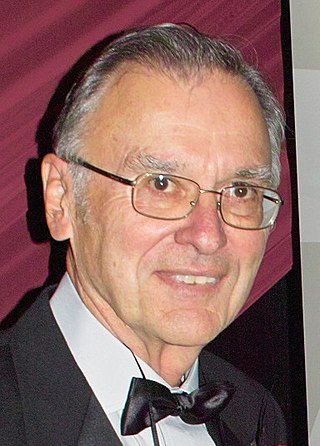
The Apple Computer 1, originally released as the Apple Computer and known later as the Apple I or Apple-1, is an 8-bit desktop computer released by the Apple Computer Company in 1976. It was designed by Steve Wozniak. The idea of selling the computer came from Wozniak's friend and Apple co-founder Steve Jobs. The Apple I was Apple's first product, and to finance its creation, Wozniak sold his HP-65 calculator for $500 and Jobs sold a second hand VW Microbus, for a few hundred dollars. Wozniak demonstrated the first prototype in July 1976 at the Homebrew Computer Club in Palo Alto, California.

Stephen Gary Wozniak, also known by his nickname "Woz", is an American technology entrepreneur, electronics engineer, computer scientist, computer programmer, philanthropist, and inventor. In 1976, he co-founded Apple Computer with his late business partner Steve Jobs, which later became the world's largest technology company by revenue and the largest company in the world by market capitalization. Through his work at Apple in the 1970s and 1980s, he is widely recognized as one of the most prominent pioneers of the personal computer revolution.

The Homebrew Computer Club was an early computer hobbyist group in Menlo Park, California, which met from March 1975 to December 1986. The club had an influential role in the development of the microcomputer revolution and the rise of that aspect of the Silicon Valley information technology industrial complex.

Eldon Hall was the leader of hardware design efforts for the Apollo Guidance Computer (AGC) at MIT, and advocated the use of integrated circuits for this task. He wrote extensively of the development of the AGC, culminating in his 1996 book, Journey to the Moon: The History of the Apollo Guidance Computer (ISBN 1-56347-185-X)

The history of computing hardware starting at 1960 is marked by the conversion from vacuum tube to solid-state devices such as transistors and then integrated circuit (IC) chips. Around 1953 to 1959, discrete transistors started being considered sufficiently reliable and economical that they made further vacuum tube computers uncompetitive. Metal–oxide–semiconductor (MOS) large-scale integration (LSI) technology subsequently led to the development of semiconductor memory in the mid-to-late 1960s and then the microprocessor in the early 1970s. This led to primary computer memory moving away from magnetic-core memory devices to solid-state static and dynamic semiconductor memory, which greatly reduced the cost, size, and power consumption of computers. These advances led to the miniaturized personal computer (PC) in the 1970s, starting with home computers and desktop computers, followed by laptops and then mobile computers over the next several decades.

Marcian Edward "Ted" Hoff Jr. is one of the inventors of the microprocessor.

Robert Elliot Kahn is an American electrical engineer who, along with Vint Cerf, first proposed the Transmission Control Protocol (TCP) and the Internet Protocol (IP), the fundamental communication protocols at the heart of the Internet.

Federico Faggin is an Italian physicist, engineer, inventor and entrepreneur. He is best known for designing the first commercial microprocessor, the Intel 4004. He led the 4004 (MCS-4) project and the design group during the first five years of Intel's microprocessor effort. Faggin also created, while working at Fairchild Semiconductor in 1968, the self-aligned MOS (metal-oxide-semiconductor) silicon-gate technology (SGT), which made possible MOS semiconductor memory chips, CCD image sensors, and the microprocessor. After the 4004, he led development of the Intel 8008 and 8080, using his SGT methodology for random logic chip design, which was essential to the creation of early Intel microprocessors. He was co-founder and CEO of Zilog, the first company solely dedicated to microprocessors, and led the development of the Zilog Z80 and Z8 processors. He was later the co-founder and CEO of Cygnet Technologies, and then Synaptics.

The history of computing is longer than the history of computing hardware and modern computing technology and includes the history of methods intended for pen and paper or for chalk and slate, with or without the aid of tables.
The year 1976 in science and technology involved some significant events, listed below.

Montana State University (MSU) is a public land-grant research university in Bozeman, Montana. It is the state's largest university. MSU offers baccalaureate degrees in 60 fields, master's degrees in 68 fields, and doctoral degrees in 35 fields through its nine colleges. More than 16,700 students attended MSU in the fall 2019, taught by 796 full-time and 547 part-time faculty.

George Robert Stibitz was a Bell Labs researcher internationally recognized as one of the fathers of the modern digital computer. He was known for his work in the 1930s and 1940s on the realization of Boolean logic digital circuits using electromechanical relays as the switching element.

Raymond Samuel Tomlinson was an American computer programmer who implemented the first email program on the ARPANET system, the precursor to the Internet, in 1971; It was the first system able to send mail between users on different hosts connected to ARPANET. Previously, mail could be sent only to others who used the same computer. To achieve this, he used the @ sign to separate the user name from the name of their machine, a scheme which has been used in email addresses ever since. The Internet Hall of Fame in its account of his work commented "Tomlinson's email program brought about a complete revolution, fundamentally changing the way people communicate." He is credited with the invention of the TCP three-way handshake which underlies HTTP and many other key Internet protocols.

The Computer History Museum (CHM) is a museum of computer history, located in Mountain View, California. The museum presents stories and artifacts of Silicon Valley and the information age, and explores the computing revolution and its impact on society.

Apple Inc, originally named Apple Computer, Inc., is a multinational corporation that creates and markets consumer electronics and attendant computer software, and is a digital distributor of media content. Apple's core product lines are the iPhone smartphone, iPad tablet computer, and the Macintosh personal computer. The company offers its products online and has a chain of retail stores known as Apple Stores. Founders Steve Jobs, Steve Wozniak, and Ronald Wayne created Apple Computer Co. on April 1, 1976, to market Wozniak's Apple I desktop computer, and Jobs and Wozniak incorporated the company on January 3, 1977, in Cupertino, California.

The Computer Museum was a Boston, Massachusetts, museum that opened in 1979 and operated in three locations until 1999. It was once referred to as TCM and is sometimes called the Boston Computer Museum. When the museum closed and its space became part of Boston Children's Museum next door in 2000, much of its collection was sent to the Computer History Museum in California.

A computer museum is devoted to the study of historic computer hardware and software, where a "museum" is a "permanent institution in the service of society and of its development, open to the public, which acquires, conserves, researches, communicates, and exhibits the tangible and intangible heritage of humanity and its environment, for the purposes of education, study, and enjoyment", as defined by the International Council of Museums.

The history of the personal computer as a mass-market consumer electronic device began with the microcomputer revolution of the 1970s. A personal computer is one intended for interactive individual use, as opposed to a mainframe computer where the end user's requests are filtered through operating staff, or a time-sharing system in which one large processor is shared by many individuals. After the development of the microprocessor, individual personal computers were low enough in cost that they eventually became affordable consumer goods. Early personal computers – generally called microcomputers – were sold often in electronic kit form and in limited numbers, and were of interest mostly to hobbyists and technicians.
Cathy Lynn Whitlock is an American Earth Scientist and Professor at Montana State University. She is interested in Quaternary environmental change and palaeoclimatology and was a lead author of the 2017 Montana Climate Assessment. Whitlock has served as president of the American Quaternary Association and was elected to the National Academy of Sciences in 2018.
















